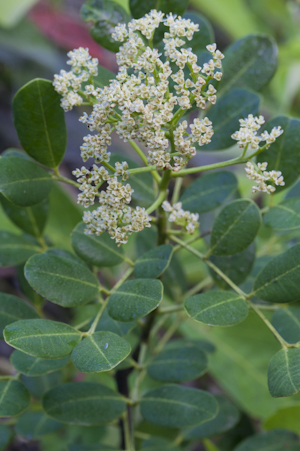Plants of South Florida · Plants by Conservation Area · Plants by County · Plants by Habitat Quick Search · Advanced Search |
||
|
|
||
 |
Zanthoxylum coriaceum A. Rich Biscayne prickly-ash |
|
|
South Florida Status: Critically imperiled. Two occurrences in three conservation areas (Hugh Taylor Birch State Park; Crandon Park & Virginia Key and Marine Stadium). Taxonomy: Dicotyledon; Rutaceae. Habit: Shrub to small tree. Distribution: Native to South Florida and the West Indies. South Florida Distribution: Broward, Miami-Dade, and Palm Beach counties. South Florida Habitats: Maritime hammocks. Protection Status: Listed as endangered by FDACS and as critically imperiled by FNAI. Aids to Identification: Nelson (1996) has a color photo; Chafin (2000) has illustrations and a color photo; the IRC Website has a color photo. References: Small, 1933a; Long & Lakela, 1976; Porter, 1976; Little, 1978; Tomlinson, 1980; Correll & Correll, 1982; Nelson, 1994; Nelson, 1996; Wunderlin, 1998; Chafin, 2000; Coile, 2000. Synonyms: None. Historical Context: Abram P. Garber first collected Biscayne pricklyash in 1877 on Virginia Key in Miami-Dade County. George N. Avery observed plants on Virginia Key several times from 1967 to 1983 (Avery’s Notes, 1967-1983). It still is present on the island at Virginia Key and Marine Stadium, which is managed by the City of Miami. Gann and Bradley observed plants there in 1999 with City of Miami naturalist Juan Fernandez. Gann and Fernandez also observed plants in 2001. In 1915, John Kunkel Small and Charles A. Mosier collected Biscayne pricklyash on “sand-dunes opposite Lemon City” (5819, US), a station about four to five miles north of the southern tip of Miami Beach. All maritime hammocks on this portion of Miami Beach have been destroyed. In 1965, John Popenoe collected Biscayne pricklyash at Crandon Park on Key Biscayne (s.n., FTG). Frank C. Craighead also collected it there later that year (s.n., USF). The species is extant there and has been observed on several occasions by the authors. Allan H. Curtiss first collected Biscayne pricklyash in Broward County in 1897 on a beach ridge in Fort Lauderdale in Broward County (5844, NY), probably in or near what is now Hugh Taylor Birch State Park. Olga Lakela and Robert W. Long collected it at the park (s.n., USF), presumably in the 1960s. Avery observed this station in 1967 (Avery’s Notes, 10 April 1967). Buckley & Hendrickson (1983b) also reported it for the park. It was observed there as recently as 1999 by Gann and Florida Park Service biologist Janice A. Duquesnel. Fewer than 10 trees remain. A single collection of this species was made at Boynton Beach in Palm Beach County by Kenneth W. Loucks and Erdman West in 1930 (s.n., FLAS). Fairchild Tropical Garden (FTG) has conducted conservation horticultural studies and has successfully propagated plants from seed. FTG and the Florida Park Service have initiated an introduction program at Bill Baggs Cape Florida State Park on Key Biscayne. FTG maintains a collection of South Florida germplasm. Major Threats: Habitat destruction and exotic pest plant invasions. Comments: Biscayne pricklyash is dioecious. Recommendations: • Voucher plants at Virginia Key and Marine Stadium. • Map and monitor known stations on a regular basis. • Continue introduction program at Bill Baggs Cape Florida State Park. • Consider reintroduction to other sites within its historical range. |
||



